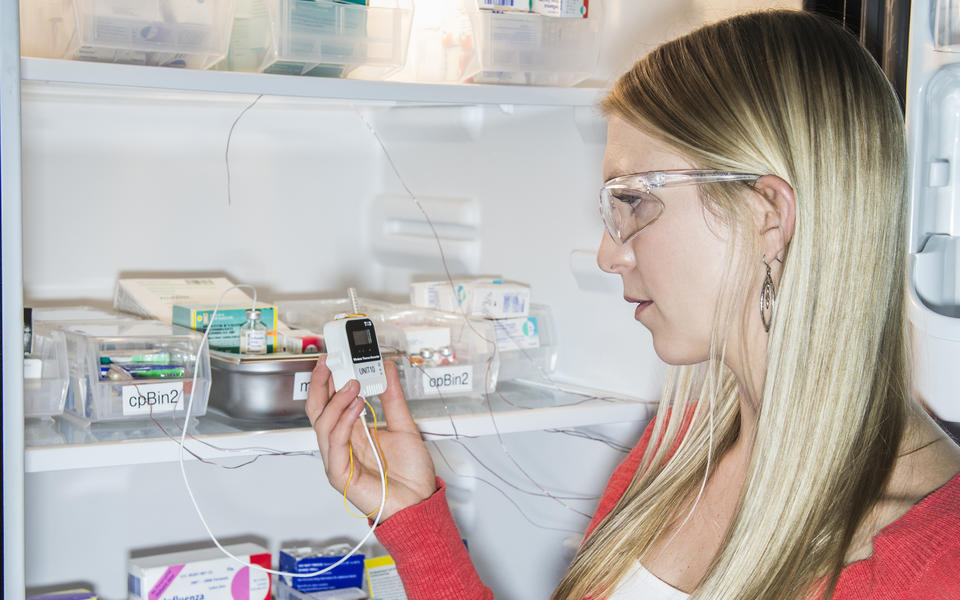Taking Measure
Just a Standard Blog

Michal Chojnacky checks vaccine temps.
Flu season typically peaks between December and February, but by the time the winter holidays roll around, many of us will have already waited in line at area clinics, grocery stores, and pharmacies to get our annual flu shot. The Centers for Disease Control reports that U.S. vaccination efforts since 1994 have prevented an estimated 16 million illnesses every year.
Even so, some people choose to avoid vaccination, citing reasons like a lack of confidence in its usefulness, complication risks, or religious beliefs. Some news outlets thrive on the controversy, sensationalizing reports of disease outbreaks, possible vaccine failures, and anti-vaccination propaganda. Yet the public debates have missed a critical factor in vaccine effectiveness: temperature.
That’s right. To work correctly, all vaccines require strict temperature control from the point of manufacture up until they are injected into a patient’s arm. Our work at NIST is helping to ensure that providers know how to maintain vaccines at the right temperatures, so those who get the shot can be confident that every dose works as intended.
Most vaccines administered in the United States must be kept between 2 and 8 degrees Celsius through a network called the cold chain. Refrigerated vaccines exposed to temperatures outside this allowable range lose their potency. Vaccines that are too warm will eventually spoil, and a single freezing event will cause irreparable damage, rendering the medication entirely useless. A 2007 meta-analysis estimated that as much as 35 percent of the world’s vaccines are subjected to accidental freezing in the cold chain.
Unfortunately, there’s no quick and easy way to determine whether a vaccine has been exposed to inappropriate storage temperatures, which means ineffective vaccines may be unknowingly administered to patients. Instead, pharmaceutical manufacturers, distributors, and immunization providers must rely on temperature monitoring devices placed in temperature-controlled storage units and shipping containers to assess vaccine viability.
The Centers for Disease Control (CDC) plays a major role in managing the U.S. vaccine market through its Vaccines for Children (VFC) program, which distributes nearly $4 billion worth of vaccines to underinsured and underprivileged children each year. Over 44,000 U.S. clinics distribute vaccines through the VFC program, and immunization providers around the country look to the CDC for guidance and policies on the best methods for storing, transporting, and monitoring vaccines under proper, temperature-controlled conditions.
In 2009, the CDC asked the NIST Thermodynamic Metrology Group for help solving problems in temperature measurement and control of vaccines distributed through its VFC program. Wasted vaccines from equipment and temperature monitoring failures at clinics around the country were adding up to a significant monetary and public health cost. When vaccine temperature excursions are discovered, costly and embarrassing re-vaccination efforts may be needed, which put communities at risk and erode public confidence. Many physicians have expressed frustration at the lack of consistent guidance and information for safely managing their vaccine supplies.
Our group is gradually bridging this knowledge gap through studies designed to replicate the vaccine storage and transport conditions that occur at the provider office level. We study vaccine refrigerators ranging from the cheapest dorm fridge available at your local big box outlet to highly-engineered, purpose-built pharmaceutical and laboratory refrigerator systems.
Each of our test refrigerators is filled with vaccines and wired up with a boatload of miniature temperature sensors called thermocouples. They are then subjected to the sorts of conditions we expect to happen in real life—repeated door opening, temperature adjustments, power failures, overloading the unit with large amounts of vaccines, and so on. We test temperature monitoring devices and setup methods to determine the best way to accurately track stored vaccine temperatures inside a unit without too much effort or expense. And we develop vaccine transport “packout” methods using readily-available materials and coolers.
From our results, we provide the CDC with user-friendly guidance on questions like: What type of vaccine refrigerator should I buy? What should I look for in a temperature monitoring device? How can I calibrate my vaccine refrigerator thermometer? How can I safely transport vaccines in an emergency? How can I best manage power failures?
One of our earliest findings was that dorm-style refrigerators are extremely unsafe for vaccine storage, as they may result in rapid, accidental freezing of vaccine. At the time, these units were commonplace in smaller clinics due to their convenient size and small price tag. Since the NIST findings were published, dorm style units have been removed from all VFC provider offices.
NIST research has generated other major improvements in vaccine management practices, including widespread use of calibrated, traceable, continuously recording temperature monitoring devices inside vaccine refrigerators—phasing out analog devices and handwritten temperature record sheets. Our studies also highlighted the importance of monitoring stored product temperature instead of air temperature, reducing vaccine waste caused by false temperature alarms.
NIST findings are repackaged and distributed through the CDC’s Vaccine Storage and Handling Toolkit, which vaccine providers, state health department immunization managers, and cold chain equipment manufacturers rely on as the primary guidebook for U.S. vaccine management policies. So if you get the flu shot and don’t get the flu this year, give some credit to CDC, NIST and a better-working cold chain.
And the next time you hear people arguing about the flu shot, you can ask what they think about cold chain management practices. It may end the discussion—or prompt a Google search.
About the author
Related Posts
Comments
- Reply
Michal, We have a patent vaccine EMR, VEMR Inc., that utilizes scanning at the admin level, controls inventory, set appointments, access to registries and most importantly cold chain management using RFID. The cost and technology has come down significantly. We would like to see this safety measure required by the pharmaceutical market. Any advise on pharmaceutical companies that are on the forefront of using this for vaccines and biologicals?
Thanks for your work addressing the vital health issue.
Hi Michelle,
I'm not sure which companies you'd want to target - as a researcher in the public service sector, this falls quite a bit outside my area of expertise. It sounds like a useful system, best of luck!





